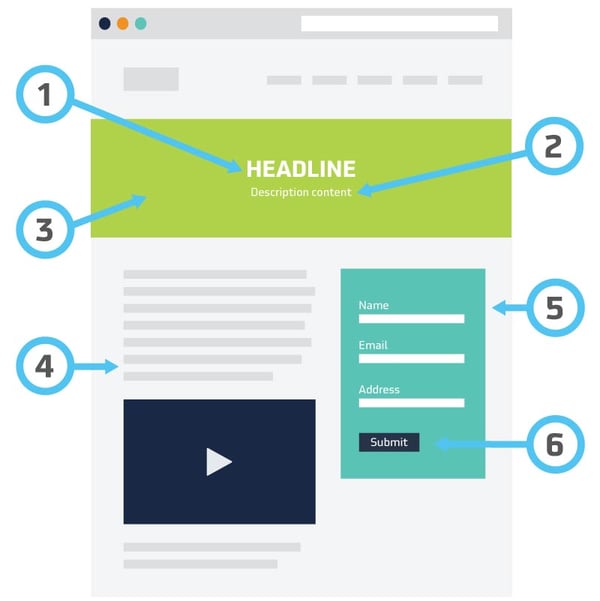It can be difficult to make pages that perform well and produce consistent, high-converting leads.
When creating manufacturing or B2B digital marketing strategies, it can be challenging to know what will work for your business. We hear it all the time from manufacturing, industrial, and B2B leaders — “digital or internet marketing just won’t work for us.” And to be honest, we get it. We know you’ve probably given this opportunity a try in the past, and it hasn’t worked out. But, we’ve worked with numerous manufacturers and B2B organizations to know that it can. By understanding the importance of strategy in digital marketing and the impact it can have on your ability to produce more leads and grow your business, you’ll be able to create a marketing program that systematically drives growth for your business over time.
One of the most significant marketing opportunities B2B and manufacturing leaders have at their disposal are landing pages. But, it can be difficult to understand how to make pages that perform well and produce consistent, high-converting leads. You may have even seen them listed inside of HubSpot’s marketing tool list but have no idea where to even begin with them, and that’s okay. In this article, we’ve collected commonly asked questions we often get from manufacturers and B2B marketing leaders. The answers will give you a clearer understanding of the power of HubSpot landing pages and why you need them in your arsenal of modern digital marketing practices.
What are landing pages?
Let's start with the most obvious question: what is a landing page? Landing pages are website pages created to convert visitors to leads. Successfully built B2B landing pages capture prospect information (such as name, company, or email address) through a form and, in return, get something of value (think ebook, guides, consultation, etc.).
The biggest difference between a landing page and a regular website page is that landing pages have one call-to-action. One; that's it. The focus of these pages is to get people to convert. These pages don't contain website navigation like regular website pages. People find these pages by "landing" on them through a CTA, by searching specific keyword phrases in search engine results pages, or SERPs, or through paid digital advertising. Without high-quality landing pages, you're missing opportunities to turn prospective individuals into paying customers.

Why is HubSpot a good option for building landing pages?
There are multiple software options on the market today that can be leveraged to build landing pages. Often we recommend creating landing pages on the CMS your website is built on if you can. It will save your team from learning another software program, prevent you from having to integrate and style another set of pages, and avoid another software license fee.
However, our favorite software for building landing pages is HubSpot Marketing Hub. While there's a whole slew of reasons we could give you of why HubSpot landing pages make the most sense for your business, here's a list of some of the most popular features:
- A WYSIWYG editor that makes building professional-looking landing pages easy
- Built-in personalization so that your customers always feel like you're speaking directly to them
- Analytics to understand who is coming to your landing pages and what they're doing when they get there
- Extensive template library for quick and easy design
- Integration with HubSpot's sales CRM software to keep customer records clean and up-to-date automatically
What should my HubSpot landing page template look like?
This is a bit of a loaded question. The answer can vary, depending on what you’re trying to accomplish. That being said, there are some frequently asked questions that we get that follow general rules or best-practice scenarios.
How long should my landing page be?
The best answer is it should be as long as it takes to make a case for your offer. For example, if your offer is a relatively simple ebook or one-sheet download, a short landing page with a paragraph and form might be all you need. On the flip side, if you’re trying to get someone to commit to an hour webinar, you might want to extend the landing page template to include more information like whey they might learn, testimonials or credentials, or speakers bios.
Does the form have to be above the fold?
Our recommendation would be not to place it too far down on the page. Generally, you don't want it lower than below a hero banner. But, as we mentioned before, depending on what you're asking someone to do or what you're trying to accomplish, you might be able to justify breaking this rule from time to time.
For instance, is it reasonable to assume a person is bought in only reading the hero information? If the answer is yes, then by all means, put that form in front of your audience as soon as possible – don't hinder their ability to convert. But if people need to know more information first, give them the appropriate opportunity to do that before pushing them to a form. If you feel like your visitors might need to scroll through the page before they're ready to hand over their info, consider making your form "sticky." This means that as they scroll down the page, the form will scroll along with them. This keeps the conversion opportunity close to the visitor as they work through the page.
Should HubSpot landing pages have navigation?
The answer to this question is largely debated and honestly similar to the points we've made in the previous two questions. It ultimately comes down to what you're trying to accomplish.
Landing pages are built with the focus for users to take one specific action, and because of that fact, many purists will say the navigation on your landing page templates should always be hidden. And it's a fair argument. You don't want to give people any other option but to complete the form. This is a decent best practice to follow. For example, if you're running a social media ad campaign for a guide or whitepaper and the landing page is created to convince prospects to download it, you probably don't need navigation on the page. Keep the focus on the intent to download the offer. This will result in greater opportunities for success in converting people into leads.
However, you can argue that B2B and manufacturing industries selling more complex products or services have a longer and more complicated buying cycle. And ultimately that's okay. There's still an opportunity to set up landing pages in a way that helps convert higher-quality leads. Some B2B landing pages encourage visitors to contact sales when they're ready to buy. These pages may feature some navigation or footer links. With these types of HubSpot landing pages, we recommend that you still focus on what you're trying to ultimately accomplish with the landing page.
What elements should a high-converting HubSpot landing page template have?
Most landing pages have a title, subheading, hero image, content, a form. Here are some insights and best practices for each element.

- Title or primary headline: Your landing page title is one of the most important elements. It needs to be well-crafted and clear because you only have seconds to grab your audience's attention. We recommend opting for clarity over being clever. While it may be tempting to have a witty opening headline, if what you're trying to communicate isn't crystal clear to your audience, then revise for an option that's simple and clear. We like headlines like "Increase profits by 30% with your same team" instead of "How to grow your business."
- Subheading or description: Descriptive content can help provide context around what you're offering. You may be able to have your copy act as the authority or value proposition for your offer. Keep this as short as you can. You don't want people to read paragraphs to understand your point; you may consider bulleted lists or short paragraphs to keep the information scannable.
- Hero image or video: Sometimes, the hero image is an afterthought when creating HubSpot landing pages. But, they need to support the offer and title of your page. An even better option is using video in the hero section. According to a 2019 Statista study, 57% of B2B companies employ video to market goods and services. Video can extend the time viewers stay on your landing page compared to static content.
- Compelling content: Your audience doesn't have a lot of time to decipher or figure out unclear or vague messaging. Make your messages clear and to the point. Make sure you provide your offer's most important benefits and features.
- Lead capture form: Keep your forms as simple as possible. It can be tempting to collect a variety of information from prospects. We've heard it before: "We need that information." But often, it's an exaggeration. Research proves the number of form fields a prospect must complete is related to the total number of submissions received. So, make sure you only ask for the information you absolutely need. Remember, you can always follow up and collect more details later down the road.
- CTA Button: You can leverage a variety of tactics on a HubSpot landing page call-to-action. Our design team is constantly testing and experimenting with options for CTAs, things like colors, outlines, wording. You can get creative with what your button says but again, make sure you're clear and use verbs to suggest action.
How can I tell if my HubSpot landing pages are working?
Hopefully, you have a good understanding of what makes up high-converting, successful landing pages on the HubSpot platform. But, now you might find yourself asking, "How do I know if these pages are working?" One of the benefits of HubSpot is the built-in analytics. You can check on these four KPIs as leading indicators of success.
- Total leads: One could argue this is the only metric you genuinely care about. How many leads are entering your pipeline on a daily or weekly basis? What's their quality level? How many leads are converting into sales or customers?
- Pageviews: This is how many people are finding your landing pages. You'll also see the ratio between page visits and conversions and the search terms used to find your page.
- View to submission rate: This metric is the number of people who visited your page and completed the form. If you can determine which of your target persona(s) submitted form most often, you should be able to glean valuable information to shape future digital marketing strategies, including emails, social media, and paid ads.
- Conversion rate: This allows you to analyze conversion rates to determine which new visitors are returning. It can also help you discern the buyer stage — awareness, consideration, decision — of a B2B lead. Again this intelligence should inform your future marketing strategies.
Don’t waste opportunities for converting leads on your website.
Lead generation is one of the top focuses in digital marketing strategies, and landing pages can be powerful tools to help drive success. There are endless possibilities available to customize and optimize them to support your marketing initiatives. An optimized landing page will motivate customers to subscribe to your newsletter, download a whitepaper, sign up for a webinar, and contact sales that you can leverage into customers for your business.
Subscribe to Our Blog
Stay up to date with the latest marketing, sales, and service tips.




